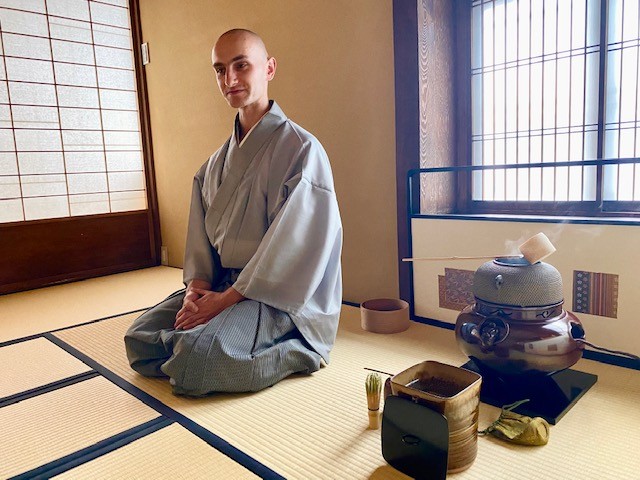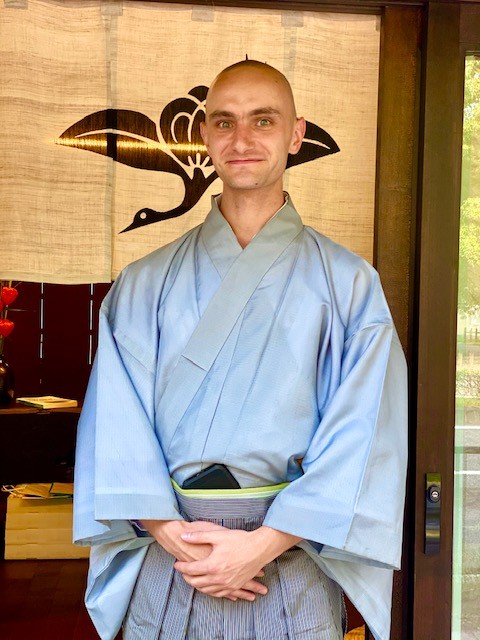
It was early on a hot summer afternoon when we got off the taxi by the gates of Gosho, the old Imperial Palace in Kyoto, to attend a real tea ceremony at The Tea Crane. I do not include the word “real” here lightly.
THE ART OF TEA
Tea ceremonies are conducted almost everywhere in Japan, and the art of tea is a favorite hobby of the cultured and intelligentsia in Japan. In addition, wives and daughters of successful men and prominent families are expected to be able to attend and to participate in a tea ceremony. The most proficient and passionate practitioners diligently study under a master. Eventually, after years of practice, they are able to conduct their own tea ceremony.
So there are many interpretations of the tea ceremony, and there are several schools and styles as well. The largest schools count many famous people among their disciples. Their events are highly anticipated. Not a few ladies long to be invited. And those who are actually spend days thinking about which kimono to wear depending on the season and occasion.
ABOUT THE TEA CRANE
In contrast, the tea ceremony we attended at The Tea Crane in Kyoto that day was one that was almost without ceremony. And this is why I call it the real tea ceremony. It was conducted by tea master Tyas Sosen, whose real name is Tyas Huybrechts. He is not Japanese by birth or lineage. However it is obvious that his heart and soul are, and these are what really matter. He studied tea under the Enshuryu school of tea.
THE JAPANESE SAMURAI & TEA

Tea Master Tyas practices the samurai version of the tea ceremony. This is really how it began, after all, as a pastime of the samurai rather than of the writers and leisure classes. Many people outside the world of tea may not understand the differences between a samurai class tea ceremony and others. The utensils and decor are the same, always chosen by the tea master to reflect his feelings and mood for that day.
One of the main differences is in the language. Archaic Japanese is used in the tea ceremony — mostly phrases of almost exaggerated politeness. However, the samurai tea ceremony uses equally archaic samurai language to convey such simple things as “I’m drinking tea ahead of you, if that’s okay.” This kind of language is learned by practitioners of the samurai school of tea. Almost no one else in the world save perhaps for descendants of samurai still living in the ancient family seat use these words.
THE REAL TEA CEREMONY
The samurai tea ceremony by Tea Master Tyas is also conducted in the same warrior spirit. It is not a fancy or elaborate ceremony but one full of serious intent and heart. Also, it is literally the real experience. A very thick (and expensive) green tea is brewed and served formally.
Tyas said: “The tea ceremony is a microcosm of Japanese culture as a whole. It encompasses the different arts and crafts and synthesizes them into one.”
He continued: “As it takes years to master and understand the tea ceremony, I can’t teach the whole of it in one day. But what I can do is give you an insight into the beauty and value this ritual has to offer.”
SIMPLICITY IN LIFE
Then there was the simple scroll and flower arrangement in the alcove of the tea room. This simple style is favored by most Japanese tea masters unless there is a reason for breaking this unspoken rule.
Tyas explained: “We don’t use foreign flowers in the arrangements in the tea ceremony room. You’ll never see roses here. So the flowers in the vase today are Kyoto flowers. As much as possible, I wish to only use Kyoto flowers.”
NEW BEGINNINGS AT
THE TEA CRANE IN KYOTO

On the other hand, Tea Master Tyas picked the scroll for its meaning. We were the first guests in the tea ceremony room and The Tea Crane was opening the following day. Aside from demonstrations and tastings, he sells his personal selection of Japanese tea. He also carries organic green tea, which is very popular among foreigners.

So he chose the scroll also for its timeliness. It was about new beginnings, and how every day or every experience happens in the time that it is supposed to. No earlier or no later. Tyas explained further: “This can also pertain to the path to enlightenment. Enlightenment cannot be rushed or contrived. It will happen in its own time.”
The warrior style ceremony, which purists consider the authentic experience, was wonderful. It was also an excellent way to spent a hot summer afternoon in Kyoto, living a Travelife. Tyas explains everything so beautifully too, as only someone truly in love with the art of tea can.
Read more about traveling around Kyoto in Travelife Magazine.









